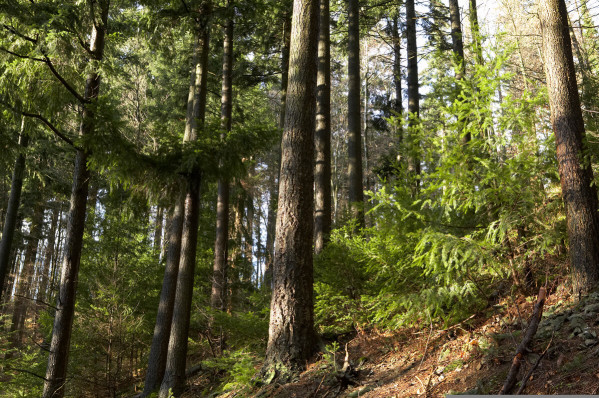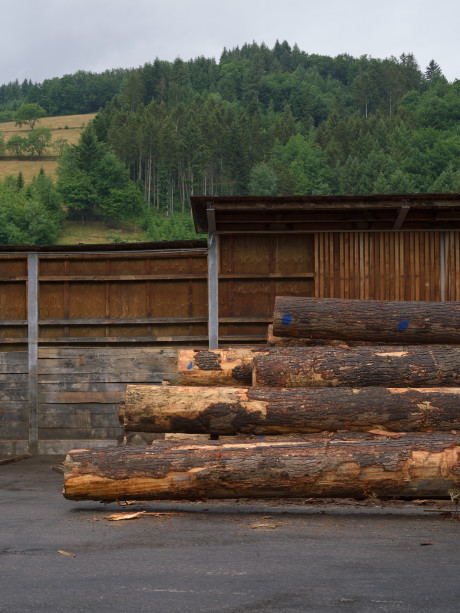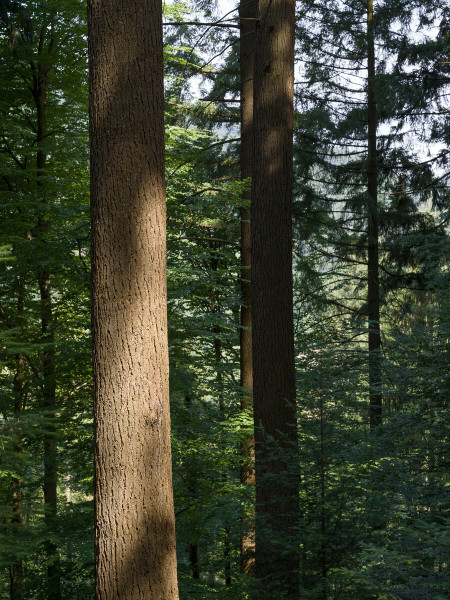
Dinesen has a deep sense of responsibility for the forest. That is why we source our timber from family-owned forests in Europe – mostly Germany – where skilled foresters have for centuries nurtured and protected the forest, preserving its ecological balance, healthy biodiversity and ideal conditions for continued growth.

The Black Forest in Southwest Germany
Our trees come from family-owned European forests – primarily the Black Forest in Germany and France. For centuries, skilled foresters have carefully tended the forests and soil and continue time-honoured traditions of sustainable forestry to grow extraordinary, majestic trees.
The Black Forest is a unique biotope. Its name refers to the shading tree species that make the wood dense and dark. The forest covers a large geographic area in southwest Germany near the Rhine and close to the borders with France and Switzerland. This vast woodland consists of multiple sections managed by different owners and foresters. With a favourable location combining mountainsides, valleys and rivers, the Black Forest is a self-regulating and natural ecosystem. That creates the right conditions for rich, balanced vegetation and healthy trees.

The Black Forest in Southwest Germany
The magnificent nature of the Black Forest
Our relationship with the forest owners and the foresters goes back a long time and is key to the selection of the right trees. The people who manage the forests know every tree and know when it is ready to be felled and begin a new life with Dinesen.
Dinesen works closely with foresters in the Black Forest, who practise the so-called Dauerwald approach, a term based on the two German words ‘Dauer’ (permanent) and ‘Wald’ (forest). In Danish, the closest to this approach is so-called Close-to-Nature Forestry. It involves letting forests develop as naturally as possible with the aim of preserving their resilience to threats such as natural disasters, disease and insect attacks.

Sawmill Messmer in the Black Forest, where the wood is prepared for transport
In the dense Black Forest, the trees stand close together, side by side, in a mix of many different species and ages, all sharing the space and giving each other strength. A high degree of biodiversity in flora and fauna provides a rich environment for the trees to thrive and grow. The species relying on seed dispersal are self-propagating while foresters assist in planting other species to help preserve biodiversity.
Dinesen’s logs come from family-owned woods, where each family makes long-term plans for management and felling with the goal of sustainable forestry. These plans usually have a 10-year or even a 100-year perspective and consider forest growths, the state of the forest and the owners’ needs in order to achieve the optimal solution for both forest and production
Felling in the Black Forest is based on selective harvesting, meaning that each tree is hand-picked, one at a time. Compared to the common method of clearcutting, which cuts down all the trees in an area, selective harvesting is more sustainable, as it helps preserve the natural forest climate. That is why Dinesen’s logs are individually selected based on our forest engineers’ unique knowledge of the age and history of each tree. The foresters follow the development of the individual trees in the forest and assess when it makes most sense to fell each one. This decision depends on several factors, including its size, how much CO2 it has stored in its lifetime and how dense the stand is – perhaps the trees around it need more light and space.


Our forest engineers measure up
Felling a Dinesen tree in the forest is a process handled with great care and precision. Our forest engineers select the right tree based on size, height and straightness – the properties that define Dinesen quality.
The forest engineer calculates and measures where the tree should fall to protect nearby trees and other vegetation as much as possible. The forest engineer then makes a cut in the tree and puts an iron wedge in place before using a chainsaw to expand the cut. Finally, the tree falls exactly where it was supposed to.
Light pours into the forest. The remaining trees benefit from their added share of water and nutrients. This creates the conditions for new generations of trees and gives them enough room to reach for the sky. By repeating this ritual, we replicate nature’s regeneration.
Every day, the foresters go through the forest to check on future trees and keep an eye out for new tasks that need to be carried out to keep the forest healthy and thriving.
A Dinesen tree is between 80 and 200 years old and is individually selected, based on structure and dimensions, to ensure that each tree represents the best nature can grow.
Our raw wood comes from four species of trees: Douglas fir, pine, oak and ash.


Slender and straight, the Douglas fir towers in the forest, growing up to 60 metres tall with a diameter of up to 1 metre. One of nature’s giants. Douglas has soft, fresh green needles and a bark that varies from brown to greyish with a coarse cork-like texture. Originating on the west coast of North America, Douglas fir was introduced to Europe in 1827. Today, Douglas firs grow in the Black Forest, among other places, and have a lifespan of 80 to 120 years.
When Douglas fir is cut into Dinesen Douglas planks, its distinct grain and slightly reddish tone become visible.

Pine is a strong, greatly prized tree that is worth the wait. It grows slowly and steadily in the German forest for 120 to 220 years until it reaches its proper, mighty size. Pine needles are twisted and blueish-green and the deeply furrowed bark ranges from grey to dark brown.
Dinesen Pine is characterised by dense grain and outstanding quality. The pine tree’s straight trunk produces exceptional planks with pride and harmonious lines. To ensure beautiful planks of the highest quality, we never select or fell the trees until the first frost has set in.

The oak tree is an impressive sight in nature. Its vitality and raw strength are reflected in its imposing posture and a lifespan of up to 500 years. Oak is a deciduous tree with characteristic, lobate leaves. When the tree has reached its optimal age, its bark is light grey, thick and crusty.
The personality and vitality of Dinesen Oak are reflected in the quality, grain and hardness of the planks. Oak is a tree with power, beauty, stability and durability, which is expressed in all of Dinesen's four variants: Oak Natural, Oak Classic, HeartOak and Layers Oak.

The ash tree stands strong, beautiful and true with a straight trunk that can grow up to 40 metres and live for up to 300 years. It has a light grey trunk that is smooth when the tree is young, but as it ages, the bark becomes crusty, with dense, deep cracks. The ash leaf is made up of multiple lancet-shaped leaflets with serrated margins.
The tree’s natural beauty and characteristic hardness are preserved in Dinesen Ash, each plank capturing its life and lines in an almost graphic expression. The decorative structure is visible in the annual rings, their colour shade varying with every season. The result is planks with a personal expression and a dynamic interplay of beautiful and contrasting light and dark tones. Our commitment to passion and respect for nature is the motivation behind Dinesen Ash, which utilises ash trees that are destined for felling

The versatile landscape makes the Black Forest completely unique
Because we follow the tree so closely during its life in the forest, we are committed to continuing to take good care of it, even after it leaves its natural habitat. It is our responsibility to give the trees we select and fell a long life as Dinesen floors or as part of other meaningful solutions. Whatever purpose the tree serves after its time in the forest, Dinesen treats it with respect throughout its lifespan.
A Dinesen floor is a natural product – grown in the forest and supplied by the trees. It is a unique piece of nature that will last as long as the tree’s life in the forest, if it is treated with respect. This means a Dinesen floor can last for centuries.
We believe the most beautiful things in the world are made by nature. Trees develop perfect imperfections, which shape their character and personality through the impact of the seasons, the soil, animals and insects and, not least, historical events and the human impact on the environment. All these influences are present as visible traces in the trunk when it is cut into floor planks, and that is what makes a Dinesen product so unique and priceless. A product that calls for care and respect. When we surround ourselves with nature’s materials, we experience the positive influence of the wood on our well-being and health.

Douglas firs stand side by side in the Black Forest

We put a lot of effort into working with knots
A tree consists of branches and leaves, which gather light for the trunk and store nutrients to enable the tree to grow. When we process the tree to make floor planks, the cut-off branches leave small knots in the trunk, where the branch emerged. Knots are the tree’s way of storing memories and telling us stories about its life in the forest. The knots are testimony to the tree’s history; the scars and beautiful traces of the powers of nature.
To us, a knot is neither a flaw nor a blemish. It is a beautiful imprint that brings life and character to a floor – a mark that reminds us of the splendour of nature. Knots make a Dinesen plank floor unique and reflect an important aesthetic perspective on nature.

Our HeartOak planks are closed with oak butterfly joints

A HeartOak plank passes through the production
We respect wood as a living material and take pride in producing unique floors that preserve the richness of nature. Therefore, we give every plank the attention it deserves. This includes preserving and – if necessary – carefully repairing knots in a way that shows respect for the tree’s personality. It also means that the planks pass through several sets of hands on their journey through the production, as they undergo repeated quality checks to make durable and unique floors.
Just as trees will always have branches, knots will always be a natural part of a Dinesen plank floor.